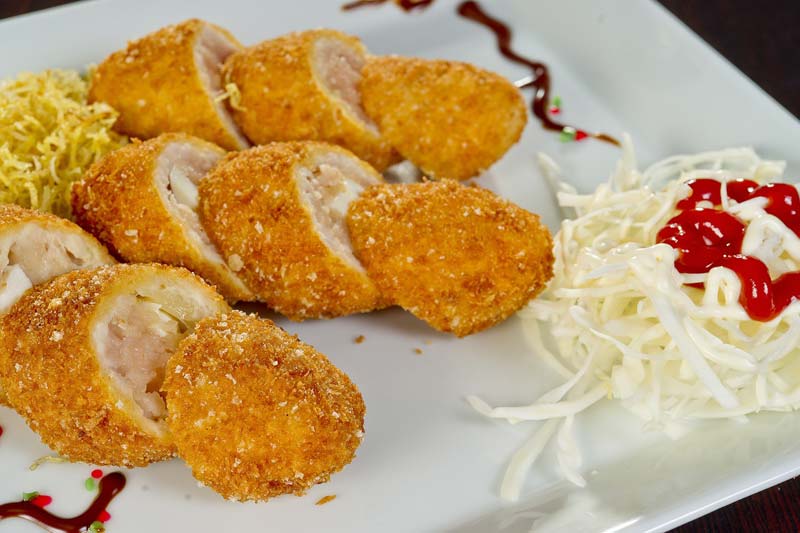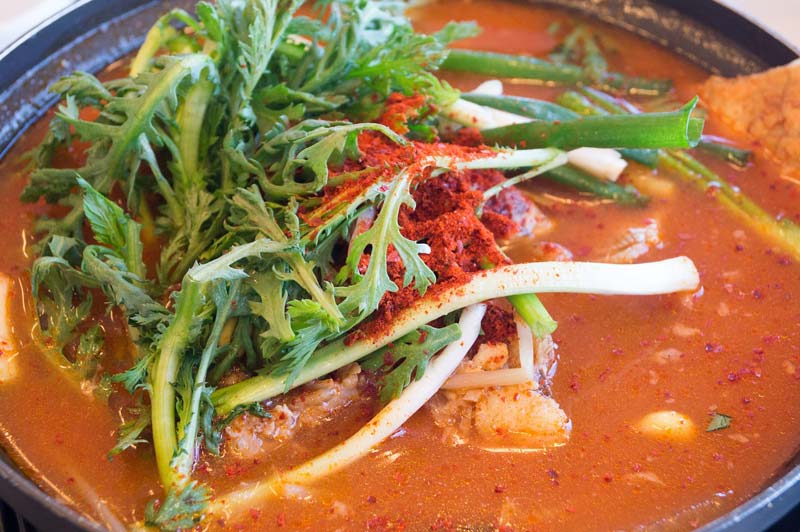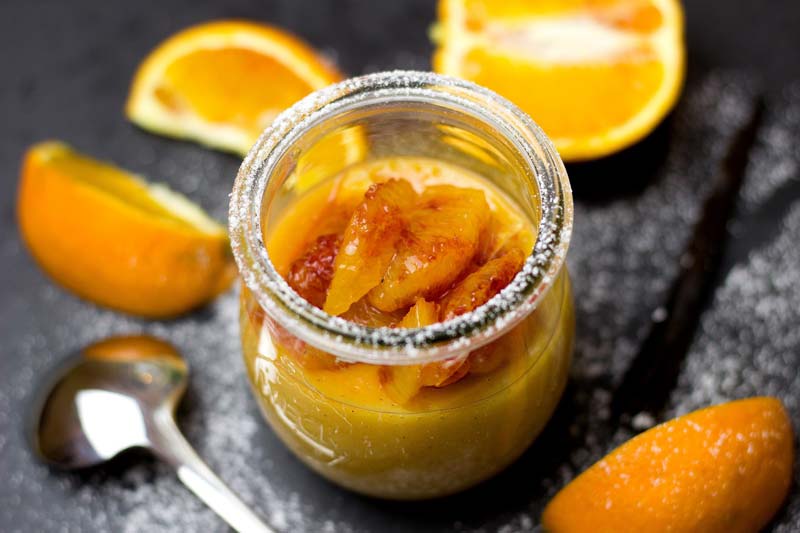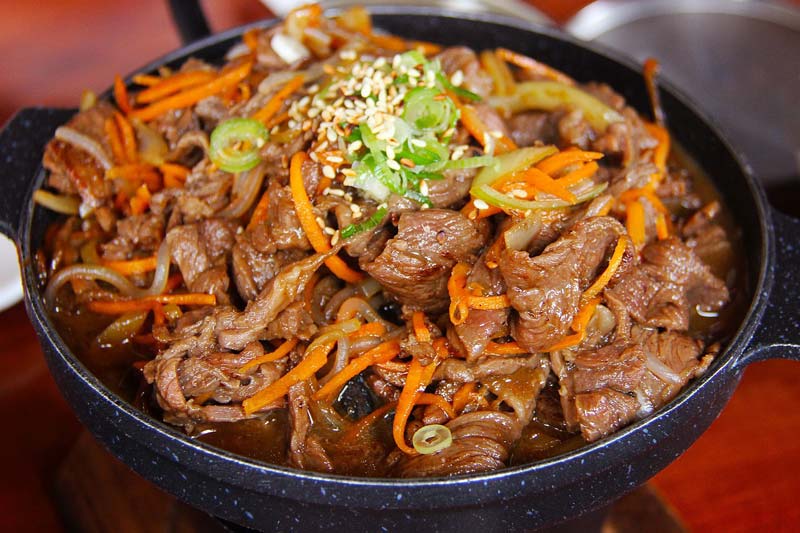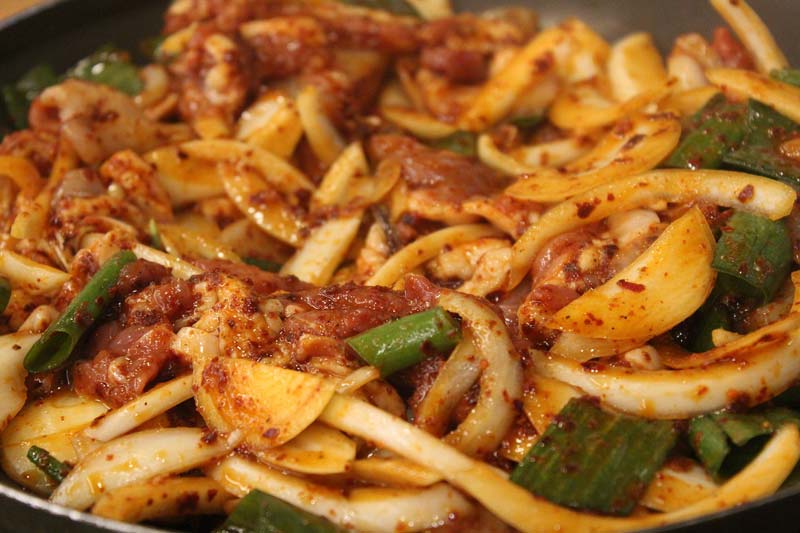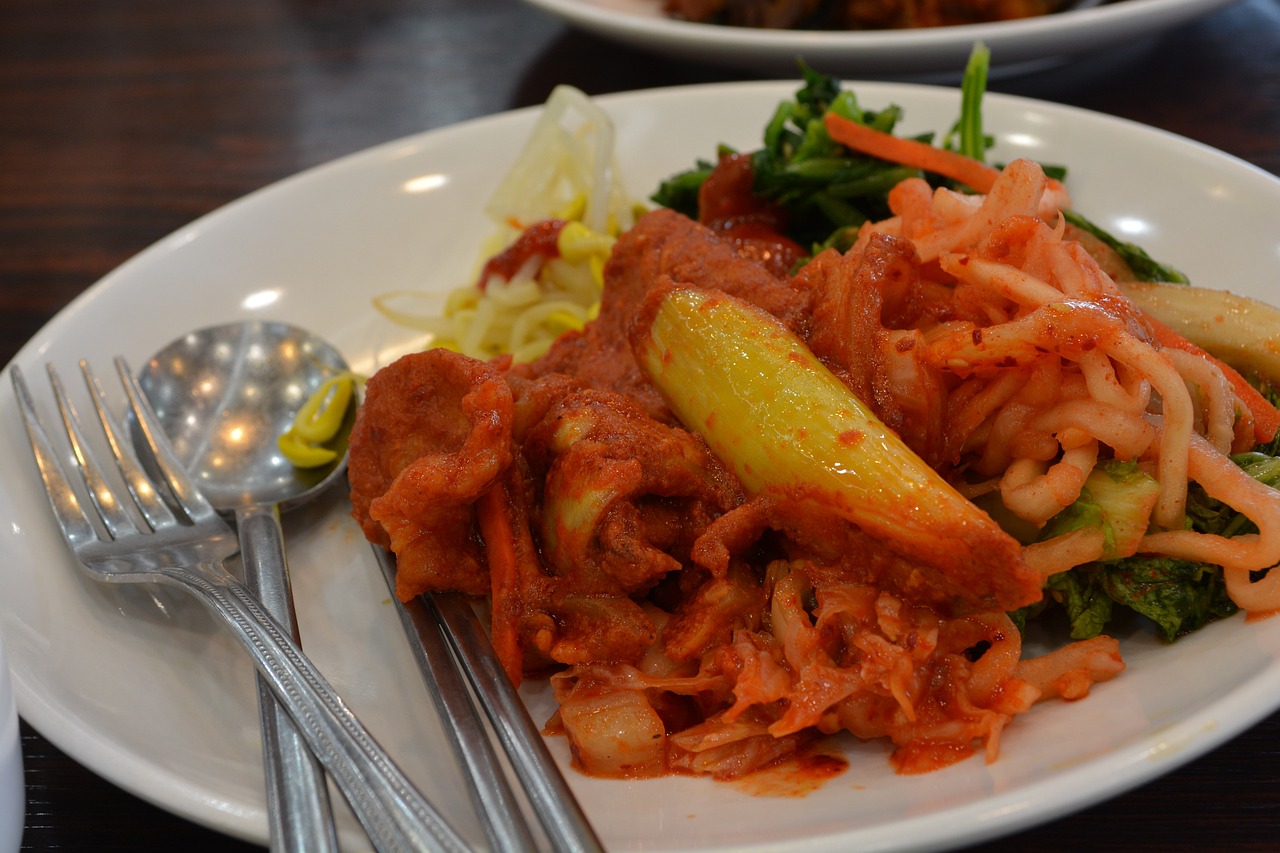Sikhye (Sweet drink made from fermented rice)
You are having perfect dessert by drinking one bowl of cool Sikhye after having eaten enough foods during festive days and feasts. On top of its taste, it is very good for digestion. Sikhye requires very simple ingredients to make and it is easy to make it but it takes for quite long hours.
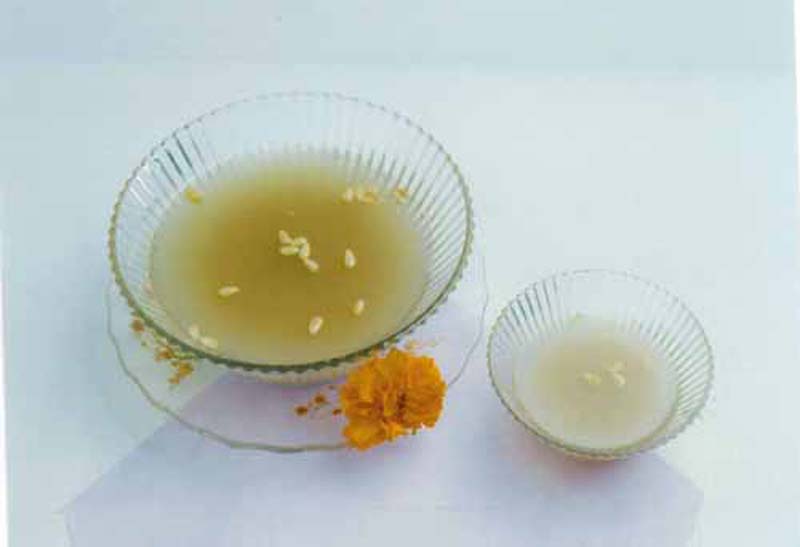
Sikhye. A sweet drink made from fermented rice., fot. Drpepper000 / wikipedia
Make steamed rice using plain rice or glutinous rice, put malt in it and leave it for one night in warm temperature. Then grains of steamed rice are fermented and come up to the surface. As the grains are fermented by the action of diastase enzyme, unique sweet taste and flavor of malt are created. When rice was fermented, boil it once again after putting sugar or honey and cooled down. It gives better taste and flavor if minced ginger or citron juice is put while boiling it.
Hwachae (Honeyed juice mixed with fruits)
From early times, our ancestors preferred to have cold drinks than hot tea.
“Hwachae” can be categorized into chinensis “Hwachae”, honey “Hwachae”, “Hwachae” made of herb ingredients and “Hwachae” made of fruits only depending on the taste of juice. Even though they are cold drinks but people enjoyed them all the year round regardless of season. In spring and summer when there are a lot of flowers and fruits, people made “Hwachae” using the flowers and fruits and enjoyed drinking them. When people put flower on the surface of “Hwachae,” the flower is coated with dry starch and put it into the boiling water for a short while and it is cooled down right away. The flower made as such which was put on the surface of “Hwachae” adds the feeling of seasonality and nutrition as well.
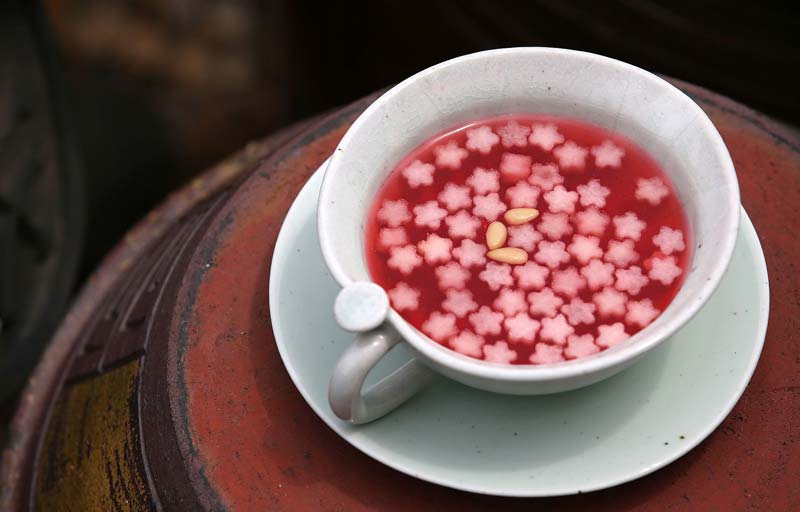
Hwachae. Honeyed juice mixed with fruits fot. Korea.net / wikipedia
In summer, watermelon Hwachae is very good for cooling down hot weather. Cut watermelon into half and take out water melon into round pieces and make cold Hwachae putting ice in it. Also there are strawberry Hwachae, peach Hwachae and citron Hwachae. To make fruit Hwachae properly, fruit juice are used in addition to sugar and pieces of the fruit should be put into the Hwachae to give more of the fruit taste.
The most frequently using material to make water for Hwachae is chinensis water. In the sweet and sour taste of chinensis water, people put azalea in spring, barley, cherry or rose flower in summer, pear in autumn and thin starch noodle in winter. “Hwachae” with thin starch noodle is called Hwamyeon (flower noodle). The fruit of chinensis has five tastes of sweet, sour, bitter, salty and hot and the texture of chinensis has strong sour taste as it contains a lot of organic acids such as malic acid and tartaric acid. Chinensis is known to be good for helping thirst and recovering from tiredness.
Sujeonggwa (Fruit punch made of dried persimmon)
When Sujeonggwa is placed outside the house for a while in winter, thin ice is created on the surface of water and soft persimmon is inside the cold water. People drink cold water first and take out soft persimmon and eat in winter, and the tastes of both water and persimmon are very good. One of the well-known Korean traditional drinks, Sujeonggwa has sweet taste as well as cassia bark and ginger’s hot taste and flavor, and the ingredients used to make Sujeonggwa are fried persimmon, ginger juice, honey and pine nuts.
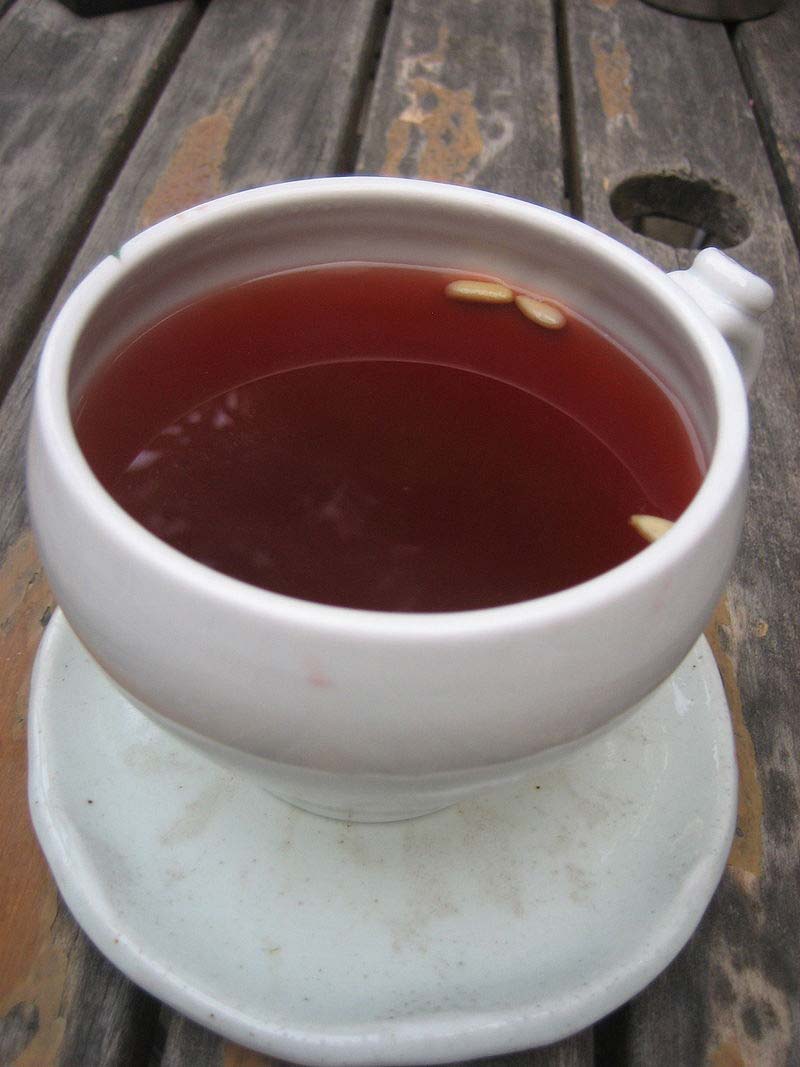
Sujeonggwa. Fruit punch made of dried persimmon, fot. by gliuoo / wikipedia
From old days, persimmon is known to have efficacy for diarrhea and stomach ache, especially it contains abundant beta-carotene. As persimmon contains more than 82% of moisture, we cannot store persimmon for long time but our ancestors demonstrated their wisdom in inventing to make dried persimmon for longer storage. We see white powder on the surface of dried persimmon but it is the ingredients of glucose and levulose. And also we put pine nuts on the surface of water, and pine nut prevents the oxidation of tannin and iron ingredients contained in the persimmon and eventually helps preventing anemia. And ginger is known to be a food which has warm nature and it makes the functions of lung and stomach healthy. Cassia bark has hot taste as well as sweet taste and therefore it helps make our body warm in winter.
Misu (Powder of roasted grains)
Misu is a cold drink which is made by pouring water to roasted grain powder little by little to mix it well in water and putting ice cubes. Some people put add sugar or honey in Misu. Misu powder is roasted grain powder and generally glutinous rice is used but barley or wheat is also used. These days, Misu powder made of five grains including bean and sesame became popular. As the starch of grains is gelatinized in Misu powder, it has been used as emergency food for war and long travel from old days.
Sudan (Rice cake in water)
“Sudan” means rice cake in water, and “Sudan is made by kneading rice powder or flour, boiling it and putting it in honeyed water together with pine nuts after cutting in the length of 1.5 inches. From old days, people made barley “Sudan” in June using freshly harvested barley in the year and barley “Sudan” is made by steaming barley, coating it with starch and putting it in chinensis water. Barley grains floating on the chinensis water with sweet and sour tastes looks very good and chewy tastes of barley grains are also very good.
Fruit Tea
From old days, our ancestors decocted herb ingredients such as date, ginseng, Japanese apricot, chinensis, Ostericum grosseserratum, Chinese matrimony vine, ginseng, cassia bark or cassia tora, or one of more kinds of fruits such as gingko nut, walnut and pear in hot water for long hours and used to drink it. These days, people like to drink the tea of plant leaves such as pine needles, persimmon leaves, Angelica Keiskei or chicory or plant roots.
Cassia mark tea is made by decocting thin sliced cassia bark in water for approximately one hour. Ginger tea is made by peeling off skin of gingers, cutting them into thin slices and decocting it in water. Ginger is also used for herb medicine. Sometimes tea is made by decocting gingko nut, data and cassia bark together. Chinese matrimony vine tea is a tea decocted using the fruit of Chinese matrimony vine, which was a cold drink in summer.
Cassia tora tea is made of the seeds of cassia tora, and the name was given as it was known to be good for eye sight. Japanese apricot tea is made of the dried fruits while its flower is used to make Japanese apricot flower tea. Japanese apricot contains a lot of citric acid which is good for the recovery from tiredness. Citron tea and Chinese quince tea are made by putting the sliced flesh of the fruits into honey or sugar for several days and boiling the clear juice called Yujacheong or Mogwacheong which are generated from the flesh and honey. In summer it can be taken as cold drinks putting Yujacheong or Mogwacheong into cold water.
Grain Tea
As ordinary tea taken at home instead of drinking plain water, barley tea and corn tea are available. Grain tea is good for health and its taste is also good but in order to make grain tea, grains should be roasted and gelatinized. As grain teas besides barley, corn and adlay teas, chicory and Solomon’s seal teas are also available which are made by soaking the fried chicory and Solomon’s seal for drink.
(korfood/korfood9_2.jsp)
